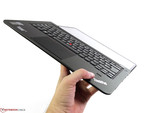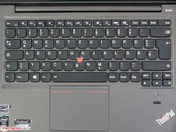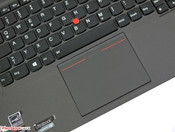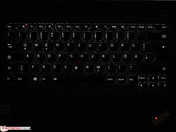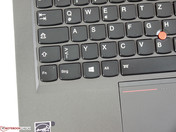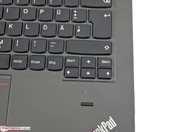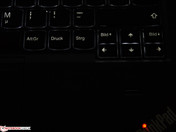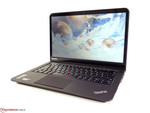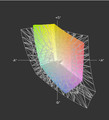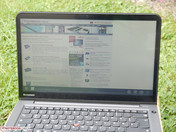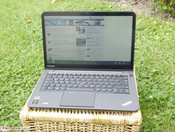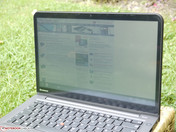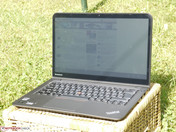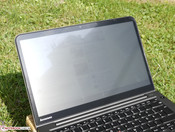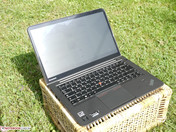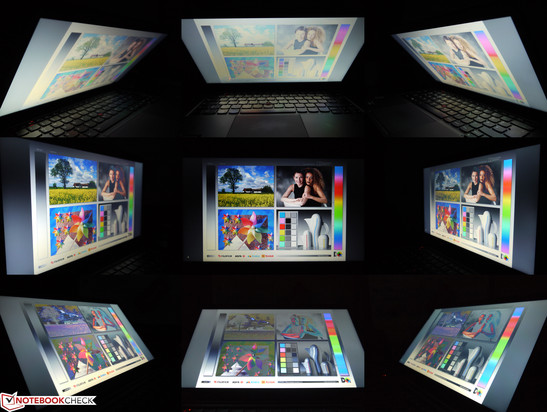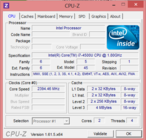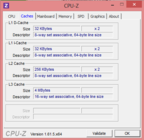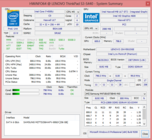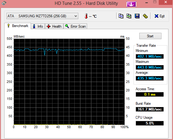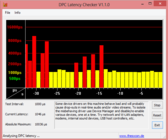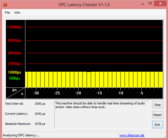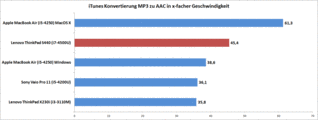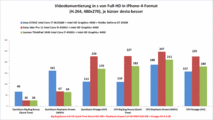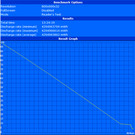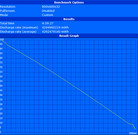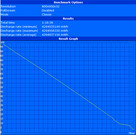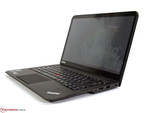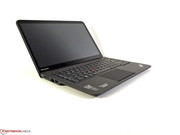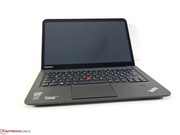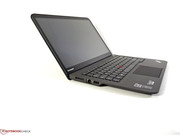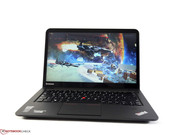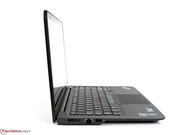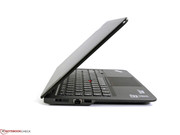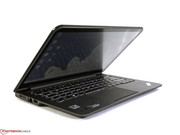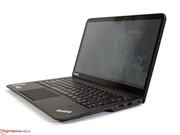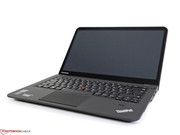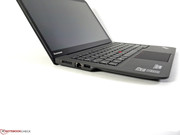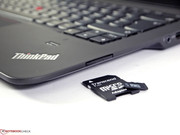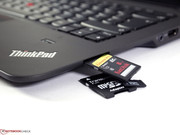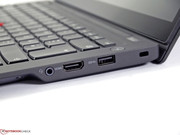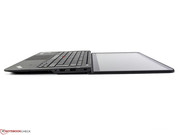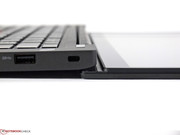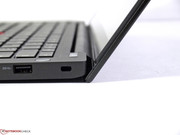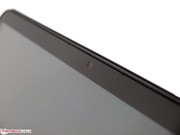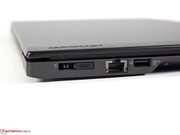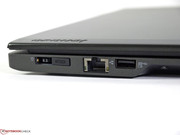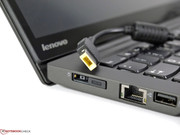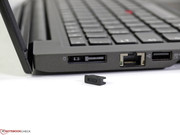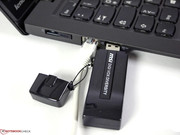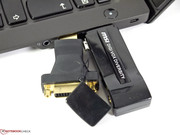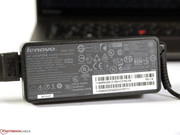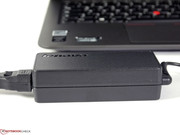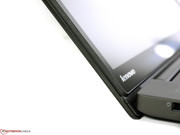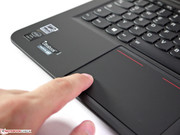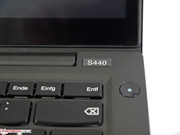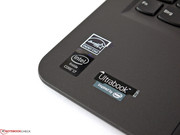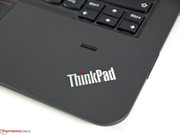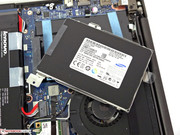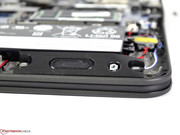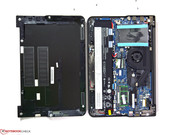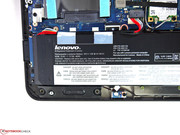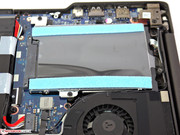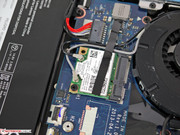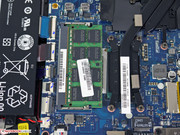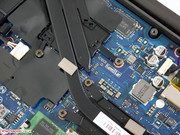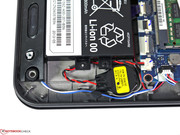Review Lenovo ThinkPad S440 Touch Ultrabook

For the original German review, see here.
Ultrabooks have become a part of Lenovo's ThinkPad series now and the ThinkPad S531 and ThinkPad S440 are the first representatives. Both models derive from the Edge series, which becomes apparent when having a look at the details. The new ThinkPad S series leaves behind the addendum "Edge" and therefore moves up the ThinkPad hierarchy into the high-quality ranks. The ThinkPad S440 is a slim 14-inch ultrabook that is supposed to combine ThinkPad's typical qualities with good battery runtimes, appealing performance and high accommodation.
Our test sample has a multitouch display with a resolution of 1600x900 pixels, an Intel Core i7-4500U CPU, switchable graphics with Intel HD Graphics 4400 and AMD Radeon HD 8670M, a 256 GB solid state drive and 8 GB RAM at its disposal. The street price is nearly 1,200 Euros (~$1585).
The case of the Lenovo ThinkPad S440 deviates from the common ThinkPad standard and is made of aluminum and a magnesium alloy. In comparison to the traditional plastic surface the sand-blasted, matte metal appears significantly more high-grade and can easily keep up with top ultrabooks like Apple's MacBook Air, Asus' Zenbook Prime or Samsung's series 7 740U3E. The ThinkPad S440 is available in silver and gunmetal but color differences can only be detected around the display lid.
We tested the darker version, which is clearly recognizable as a ThinkPad. Processing, case stability and surface quality are flawless. Only the display can be twisted slightly. The display hinges are very tight and keep the display in its position even under difficult circumstances. The four rubber feet at the bottom assure secure standing. The inner components can be accessed after opening a big lid that is held by 8 Phillips screws.
Apart from those appealing features, the buyer has to live with a slightly higher weight though. The detected 1.86 kg of the test model is not too bad, but compared to a Lenovo X1 Carbon (1.5 kg) or a Fujitsu LifeBook U772 (1.4 kg) it is no lightweight. According to the data sheet, the variant without touch-sensitive screen is two millimeters thinner and also approx. 140 g lighter.
Lenovo's ultrabook ThinkPad S440 is equipped with a practice-oriented range of interfaces. 2x USB 3.0, Gigabit-LAN and a card reader build an attractive basis. Unlike typical business notebooks, external displays are not connected to the S440 via DisplayPort but HDMI. An analog VGA port is not available. In stationary operation Lenovo's OneLink interface replaces the docking port that is usually integrated at the bottom of the ThinkPads. Appropriate docking stations (e.g. Lenovo 4X10A06083 OneLink dock black, approx. 100 Euros, ~$132) can be connected via the OneLink connection which also includes the power supply.
Communication
The key element of the communication equipment of the ThinkPad S440 is Intel's Wireless-N 7260 module. It already supports the current 802.11 ac standard, is equipped with two antennas, transfers data at a speed of up to 867 Mbit/s (gross) and radios in the 2.4 GHz and the 5 GHz bands. A Bluetooth 4.0 chip is integrated into the module for short distance radio. The WLAN connection with an 802.11 n router with Ralink RT2860T chip was very convincing in our field test and revealed no abnormalities. The transfer rates should be considerably higher though, in combination with a router that already supports the ac standard.
Lenovo offers no option concerning mobile internet connections. An internal UMTS or LTE module is neither configurable nor subsequently integrable. We did not find an appropriate slot with prepared antennas inside. If necessary the user has to fall back on USB sticks, mobile UMTS/LTE routers or smartphone tethering. Gigabit Ethernet is available for tethered network connections. Video telephoning is carried out via the 720p webcam in the display frame.
Security
The safety features of the ThinkPad S440 include a fingerprint reader, BitLocker drive encryption and the conventional Bios and operating system password options. On the one hand, a smart card reader or face recognition are missing, on the other hand, it offers Intel's Anti Theft and Computrace service if needed. Both of them are already activated in the BIOS (F1) of the test device.
Maintenance
All essential components are found underneath the lid at the bottom. Various 2.5-inch mass memory devices with a maximum design height of 7 mm can be built in. Additionally, an M.2 slot that can accommodate respective read-only memory devices is available. The main memory is limited to a maximum of 8 GB DDR3L (1,600 MHz) per slot. Our test sample is already fully equipped. The modules of the models with 4 GB RAM could be substituted with bigger ones. Furthermore, the fan and the screwed battery can be accessed, whereby the battery can be replaced in the event of damage.
Warranty
The warranty is one indicator that Lenovo's ThinkPad S440 derived from the Edge series. With a warranty of 12 months it is significantly shorter than, for example, that of the T models. Those who are not satisfied with the warranty and the additional legal warranty obligation can buy an inexpensive warranty extension. For instance, a ThinkPlus on-site service with a runtime of 36 months is available for about 80 Euros (~$105).
Keyboard
The chiclet keyboard turned out well and stands for the typical ThinkPad qualities. The keys have a medium short stroke, and offer a good pressure point and a fairly quiet tapping noise. The keyboard pad is rigidly supported and cannot be bent. We did not detect any bouncing of the keys, clacking or other weaknesses. A small point of criticism is the vertical arrow keys. They lie a little bit too close to each other and therefore provoke misentries. Apart from that, the keys are of sufficient size, arranged in a 19 mm grid and provided with high-contrast labeling. The integrated keyboard illumination can be regulated in two degrees and improves the legibility in dark environments. As is common for Lenovo, the layout is equipped with some special features that newcomers first have to adjust to. For instance, the "Ctrl" and the "Windows" key at the left side of the space bar are switched and the "Print" key is located at the right of the "AltGr" key.
Touchpad
The touchpad is equipped with a 100 x 75 millimeter glass surface with laudable gliding qualities. Windows 8 gestures and finger input are detected very well. The input field as a whole can be pressed down and replaces the previously separately implemented touchpad and trackpoint buttons. The lower area, where the touchpad buttons used to be, reacts reliably to input. Additionally, the right and left side are distinguished very well. However, it does not work too well in combination with the trackpoint. Working with the upper side of the clickpad takes some time getting used to and cannot keep up with the usual solution of additional buttons concerning convenience and reliability.
Multitouch Surface
In addition to keyboard, trackpoint and touchpad the test model has another option for input; the display surface. The matted screen has no detectable disadvantages in comparison to the normally used glossy surfaces. Its gliding qualities are good and multitouch gestures are easily understood. The display can differentiate up to 10 fingers and convert respective gestures. The operating and input angle of the display requires some time getting used to though. In this regard tablets and convertibles are much more pleasant to operate.
Lenovo offers the ThinkPad S440 with displays with a resolution of either 1366x768 pixels or 1600x900 pixels. Both of them are based on TN technology, are illuminated by (mock) white LEDs and have a matted surface. We have the HD+ display with a touch-sensitive surface in our test. This variant increases the thickness of the display lid by about 2 millimeters in comparison to the standard display and also causes a slightly higher weight.
The matted surface is not comparable to that of real matte displays. Reflections are visibly reduced but not fully eradicated. In addition to that the display is not as sharp as that of glare displays but seems somewhat grainy. Apart from that the 1600x900 pixels offer a good balance between display surface and object/font size. A dot density of 131 dpi should be pleasant for most users when working.
| |||||||||||||||||||||||||
Brightness Distribution: 81 %
Center on Battery: 174 cd/m²
Contrast: 282:1 (Black: 0.6214 cd/m²)
ΔE ColorChecker Calman: 8.11 | ∀{0.5-29.43 Ø4.77}
ΔE Greyscale Calman: 9.94 | ∀{0.09-98 Ø5}
42% AdobeRGB 1998 (Argyll 1.6.3 3D)
46.11% AdobeRGB 1998 (Argyll 3D)
66.4% sRGB (Argyll 3D)
44.61% Display P3 (Argyll 3D)
Gamma: 2.61
CCT: 11564 K
When turning the device on it is apparent that the display is not particularly bright. The subjective impression is confirmed by the indifferent results of our nine measuring points. Lenovo promises a brightness of 250 cd/m² in the data sheet. We could only measure a brightness between 163 cd/m² at the bottom left corner up to 192 cd/m² in the right center. This averages 174 cd/m² at an illumination of 81%. We could not find a way to increase the luminosity in the BIOS, the energy profiles, or the graphics drivers.
The ascertained brightness suffices for indoors and can be adapted to the individual requirements in 10 steps from 2 cd/m² to 175 cd/m². We measured 143 cd/m² at step 9, which we also used for the WLAN test. The matted surface reduces mirror images significantly and pushes them to the background sufficiently.
The ThinkPad S440 is only to a limited extend usable outdoors. When positioned correctly in the shade, it is only just possible to work. However, it is very annoying to operate like this for longer periods of time. Under direct sunlight the content of the screen becomes nearly unrecognizable and the screen is dominated by diffuse reflections. The display brightness is not lowered compulsorily during battery use.
The news is barely better concerning contrast and color space. The contrast of 282:1 and the total number of educible colors with a color space coverage of 61% of the sRGB color space are quite low.
Other display qualities like grayscale resolution, color accuracy and color saturation differ strongly from the ideal at delivery condition. Color accurate tasks cannot be done with a DeltaE 2000 that lies above 10 in many sections. The values are considerably improved after calibration and the differences to the ideal reduced to a barely noticeable degree. Afterwards the DeltaE 2000 is, for example, at about 2.5 concerning grayscale and colors.
The viewing angle stability of the TN panel is only standard for notebooks. In a vertical direction the colors either bleach out quickly or they invert, depending on the display inclination. In a horizontal direction the display suffers under a change of brightness. However the content always remains clearly perceptible.
There are many options to choose from when configuring the ThinkPad S440. The built-in components are altogether designed for low power consumption though. For instance, Lenovo invariably uses Intel's ULV CPUs and as main memory the slightly more energy-efficient DDR3L type (low power). The buyer can currently choose between an Intel Core i3-4010U and an Intel Core i7-4500U processor. In the data sheet you also find a compromise solution in the form of the Intel Core i5-4200U, which was not available in any configuration at the time of the test though. Other than that models are offered with and without dedicated AMD Radeon HD 8670M graphics card that also distinguish themselves concerning mass memory and RAM. We have the i7 model with AMD graphics card, 8 GB RAM and a 256 GB solid state drive in our test. The price is nearly 1,200 Euros (~$1585).
Processor
The ultra-low-voltage CPU Core i7-4500U has a particularly low thermal design power of 15 watts. Chipset, memory controller and integrated graphics are already contained herein. The base speed of 1,800 MHz can be increased up to 3,000 MHz (single-thread) via Turbo Boost, depending on the state of charge. This technology is especially noticeable with programs that can only use one processor core. Due to hyper-threading 4 threads can be worked on at once as well though, which in turn lets software that is able to spread the work load on several processing units profit from this.
The processor performs well in the benchmarks and is about level with a conventional Intel Core i5-2540M CPU with a TDP of 35 watts. The Intel Core i7-4500U scored 5897 (single) and 11183 (multi) points in the Cinebench R10 64. The SuperPi 32M calculation (single) is finished in 655 seconds and the wPrime 1024m calculation (multi) takes 615 seconds.
We did not ascertain any throttling of the performance during battery use. The score of the Cinebench R11.5 (multi) 64-bit is with 2.77 points even marginally higher than during power supply operation (2.74 points).
System Performance
The system performance is overall very positive, but could have been improved with a second main memory module. The main memory uses only one memory bank and therefore runs only in single-channel mode. This influences the memory speed on the one hand and the dependent graphics performance of the integrated Intel HD Graphics 4400 on the other. The graphics card does not have its own graphics memory and has to fall back on the main memory. Previous tests revealed performance differences of about 20-30% in comparison to configurations with dual-channel memory.
The AMDs Radeon HD 8670M is not affected by this since it has its own DDR3 memory. It scores 4,883 points (PCMark 7) and 13,390 points (PCMark Vantage) in the system benchmarks.
We check the system for possible latencies during the use of external peripherals with the DPC Latency Checker. We observed high peaks with enabled radio modules that were reduced to about 1000µs in flight mode. Driver updates could solve this problem in the future. Until then users of sensitive devices simply need to turn the interfering components off.
| PCMark Vantage Result | 13390 points | |
| PCMark 7 Score | 4883 points | |
Help | ||
Storage Devices
So far only models with 2.5-inch solid state drives are available, which have a capacity of either 128 GB or 256 GB (gross). The configuration list also lists variants with conventional hard drives and cache modules that might appear in future configurations. The ThinkPad S440 is already equipped with one slot for solid state drives in the M.2 format (SATAe). However, it is currently nearly impossible for the end-user to attain an according module.
Our test device has a 256 GB (gross) solid state drive by Samsung (MZ7TD256HAFV-000L9). With sequential write rates of about 250 MB/s and sequential read rates of nearly 480 MB/s it is one of the faster drives, which is co-responsible for the tangibly high system speed. Further positive features are short access times and an inaudible operation that prove the substantial added value in comparison to conventional hard drives.
Graphics Card
The ThinkPad S440 has two graphics chips at its disposal that both can be used. The processor-integrated Intel HD Graphics 4400 is mainly active for low-performance tasks while the dedicated AMD Radeon HD 8670M is supposed to undertake more demanding 3D tasks. The ascertained performance difference is disappointing though: The AMD solution can only partly pull away even though the integrated Intel HD Graphics is slightly thwarted due to the missing dual-channel mode of the main memory. The difference is only in a few cases (mainly games) big enough for practical use to classify the HD 8670M as first choice. Reasons are, among other things, the 64-bit quite narrowly designed memory bus and the relatively slow DDR3 graphics memory.
The Lenovo ThinkPad S440 with AMD graphics card scores 4,077 points in 3DMark Vantage and 21.58 fps in Cinebench R11.5 64 bit. With Intel graphics card the system only reaches 3,325 points and 15.15 fps. See the table below for further comparisons.
| Intel HD Graphics 4400 (Core i7 4500U, Single Channel) | AMD Radeon HD 8670M (2GB DDR3) | |
| 3DMark06 | 4456 points | 4.642 points |
| 3DMark Vantage | 3.325 points | 4.077 points |
| Cinebench R10 OpenGL 64-bit | 5.511 points | 6.010 points |
| Cinebench R10 OpenGL 32-bit | 5.420 points | 5.941 points |
| Heaven 2.0 | 10.9 fps | 12.5 fps |
| World of Warcraft (low) | 199 fps | 237 fps |
| World of Warcraft (mid) | 70 fps | 73 fps |
| World of Warcraft (high) | 19 fps | 21 fps |
| Torchlight 2 (low) | 86 fps | 102 fps |
| Torchlight 2 (mid) | 30 fps | 63 fps |
| Torchlight 2 (high) | 14 fps | 37 fps |
| F1 2012 (low) | 38 fps | 60 fps |
| F1 2012 (mid) | 27 fps | 46 fps |
| F1 2012 (high) | 19 fps | 42 fps |
Some programs like Cyberlink's Media Espresso 6.5 simply could not be used with the AMD Radeon HD 8670M in the test. A manual assignment was not possible. Therefore our video conversions could only be executed via CPU and Intel Quick Sync Video (also see the segment "Processor" on this point). We observed a considerable performance plus and a lower processor load when programs were able to access interfaces like Intel Quick Sync, OpenCL or AMD Accelerated Parallel Processing. This frees up performance for other applications while the conversion is running in the background.
We did not detect any reduction of the graphics performance (AMD Radeon HD 8670M) during battery use or under full load.
| 3DMark 06 Standard Score | 4642 points | |
| 3DMark Vantage P Result | 4077 points | |
| 3DMark 11 Performance | 1259 points | |
| 3DMark Ice Storm Standard Score | 38463 points | |
| 3DMark Cloud Gate Standard Score | 3713 points | |
| 3DMark Fire Strike Score | 699 points | |
Help | ||
Gaming Performance
Games can mainly be played at low and medium settings with the AMD Radeon HD 8670M. Only a few titles like Torchlight 2 or F1 2012 allow a little bit more. Alan Wake has to be classified as not playable since it feels more like a slide show even at basic settings.
| low | med. | high | ultra | |
|---|---|---|---|---|
| World of Warcraft (2005) | 237 | 73 | 21 | 10 |
| Anno 1404 (2009) | 119 | 16 | ||
| StarCraft 2 (2010) | 154 | 29 | 14 | 8 |
| Total War: Shogun 2 (2011) | 105.8 | 22.48 | 9.15 | |
| Anno 2070 (2011) | 52 | 28 | 15 | 9 |
| Alan Wake (2012) | 19 | 10 | 5 | |
| Diablo III (2012) | 52 | 36 | 29 | 17 |
| Sleeping Dogs (2012) | 38.5 | 29.4 | 13.6 | 5 |
| Torchlight 2 (2012) | 102 | 63 | 37 | |
| F1 2012 (2012) | 60 | 46 | 42 | 20 |
| World of Tanks v8 (2012) | 67 | 26 | 21 | 11 |
| Tomb Raider (2013) | 46 | 24 | 15 | 6 |
System Noise
The noise generation of the Lenovo ThinkPad S440 is very low. The fan is only occasionally activated at low load and is deactivated again shortly after. Besides that the cooling system is mostly quiet in this condition. It does not make a difference if the integrated Intel HD Graphics 4400 or AMD's Radeon HD 8670M is set as standard graphics processing unit. We could not measure a relevant difference.
The fan is clearly audible at constant medium load and with activated dedicated AMD graphics card. The measured noise level of 33.9 dB(A) is still relatively low though. Under full load the sound pressure level increases to 38.2 dB(A) but does not rise any further under permanent stress. Once a load phase is terminated, the fan speed decreases very quickly only to completely fall silent moments later. Apart from the low noise level, the characteristic of the fan is also very pleasant due to its sonorous noise. It does not annoy the user with high frequency or hectic noise generation.
Noise level
| Idle |
| 28 / 28 / 28 dB(A) |
| Load |
| 33.9 / 38.2 dB(A) |
 | ||
30 dB silent 40 dB(A) audible 50 dB(A) loud |
||
min: | ||
Temperature
The surface temperatures vary significantly depending on the application. At low load the notebook is markedly cool and reaches a maximum temperature of 33.4 °C at the fan outlet underneath the display.
Under constant full load the case material becomes part of the cooling system and emits waste heat to the surrounding area. This leads to very high case temperatures that can reach up to 62.5 °C at the fan outlet around the display. We can only recommend stationary operation since we measured temperatures of far over 45 °C at other parts of the case as well. Using the laptop on your lap is not advisable because wide areas of the bottom become uncomfortably hot.
We did not ascertain any CPU or graphics throttling. With 2.7-2.9 GHz the CPU runs far above its nominal speed of 1.9 GHz and the GPU constantly runs at its maximum speed.
(-) The maximum temperature on the upper side is 62.5 °C / 145 F, compared to the average of 34.3 °C / 94 F, ranging from 21.2 to 62.5 °C for the class Office.
(-) The bottom heats up to a maximum of 55.7 °C / 132 F, compared to the average of 36.8 °C / 98 F
(+) In idle usage, the average temperature for the upper side is 29.8 °C / 86 F, compared to the device average of 29.5 °C / 85 F.
(±) The palmrests and touchpad can get very hot to the touch with a maximum of 37 °C / 98.6 F.
(-) The average temperature of the palmrest area of similar devices was 27.6 °C / 81.7 F (-9.4 °C / -16.9 F).
Speakers
The speakers are located at the front and emit their sound diagonally downwards. The sound characteristic is treble-prone with only little mid and base frequencies. This should suffice, however, for system sounds, short internet clips or some background music. The maximum volume is quite low for presentations or other tasks with several attendees and is somewhat distorted at the last steps. External boxes can be connected via 3.5 mm jack, USB, HDMI or Bluetooth. The combined audio-in/out connection requires either an adapter when using a headset or a headset with only one plug for in and out.
Power Consumption
The extensively used energy-efficient components have quite a positive impact on the power consumption which was measured at the mains. We measured a consumption of 5.7 watts with Intel HD Graphics 4400, minimum display brightness, activated energy-saving mode and flight mode. The consumption increases to 8.1 watts with Intel graphics card, maximum brightness and the balanced energy profile. The Lenovo ThinkPad S440 requires 41.4 watts under full load, simulated with Prime95 and Furmark. The power supply has a nominal power of 65 watts and therefore enough reserves. Power supply throttling did not occur.
| Off / Standby | |
| Idle | |
| Load |
|
Key:
min: | |
Battery Runtime
Lenovo installed a lithium-polymer battery with a capacity of 46 Wh for battery use. Unlike most of the ultrabooks, the battery of the Lenovo is not glued but only screwed in and can be replaced if necessary. It is not made for constant switching though, for example to increase battery runtimes.
The components are able to optimize their consumption during battery use even further, leading to a runtime of 13:24 hours in the Battery Eater Reader's test (minimum display brightness, energy-saving mode, Intel HD Graphics 4400, flight mode). In terms of figures this is equivalent to a consumption of about 3.5 watts. The ThinkPad S440 lasts for about 5 hours in the WLAN test (energy-saving mode, 143 cd/m² display brightness (set at 9), Intel HD Graphics 4400, radio modules activated). The runtime decreases to 79 minutes in the Battery Eater Classic test (maximum display brightness, high-performance profile, AMD graphics card, radio modules activated).
Verdict
Lenovo's ultrabook ThinkPad S440 scores in many respects and can even set some records in partial areas: The noise generation, the keyboard, the connectivity and the accessibility of the components are convincing. The aluminum case is very sturdy and processed flawlessly.
The performance is overall good and suffices for many applications. The circumstance that the notebook reaches such high case temperature under constant full load is not uncommon for such slim cases. However, it affects the handling negatively.
The performance plus of the dedicated AMD graphics card is disappointing though. It can only slightly outperform the integrated Intel HD Graphics 4400 when playing games.
The qualities of the display are outdated. A considerable faux pas especially in this price segment: The brightness remains far underneath that of the manufacturer's information, the contrast is dull and the vertical viewing angle stability low. The quickly responding multitouch surface, the HD+ resolution and the matted surface are only a crumb of comfort since the main features are simply inadequate.
If it wasn't for this considerable constraint, the Lenovo ThinkPad S440 could keep up with the competition and be a serious contender.



